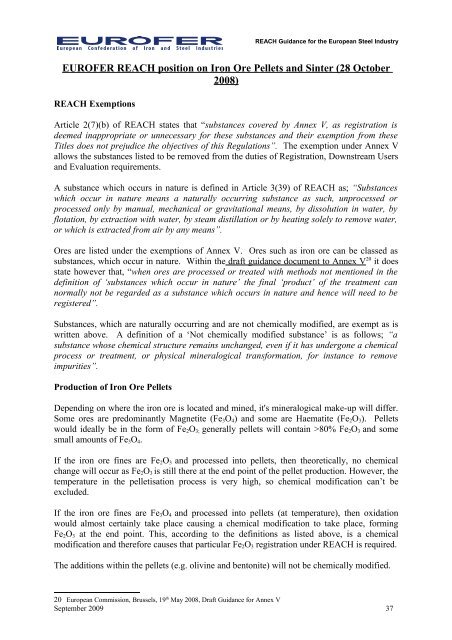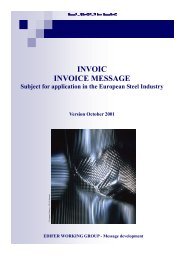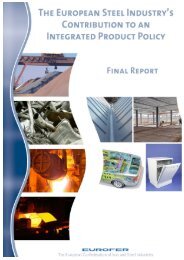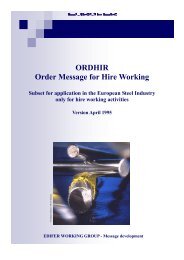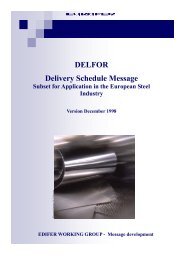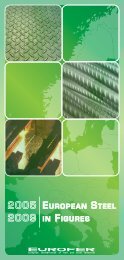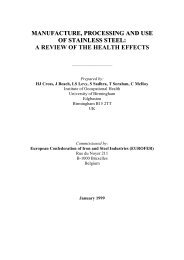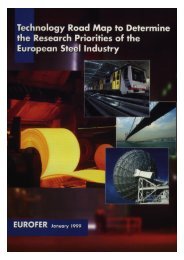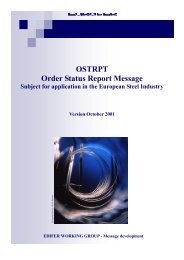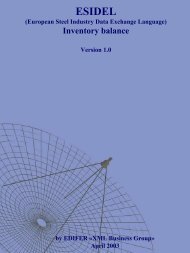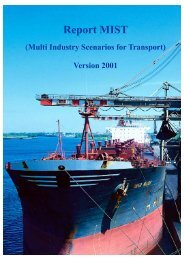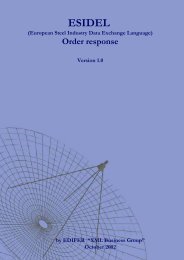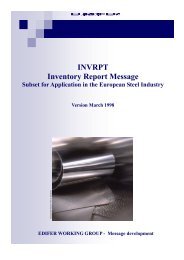EUROFER REACH guidance for the European Steel Industry. 09.09 ...
EUROFER REACH guidance for the European Steel Industry. 09.09 ...
EUROFER REACH guidance for the European Steel Industry. 09.09 ...
Create successful ePaper yourself
Turn your PDF publications into a flip-book with our unique Google optimized e-Paper software.
<strong>REACH</strong> Guidance <strong>for</strong> <strong>the</strong> <strong>European</strong> <strong>Steel</strong> <strong>Industry</strong><br />
<strong>EUROFER</strong> <strong>REACH</strong> position on Iron Ore Pellets and Sinter (28 October<br />
2008)<br />
<strong>REACH</strong> Exemptions<br />
Article 2(7)(b) of <strong>REACH</strong> states that “substances covered by Annex V, as registration is<br />
deemed inappropriate or unnecessary <strong>for</strong> <strong>the</strong>se substances and <strong>the</strong>ir exemption from <strong>the</strong>se<br />
Titles does not prejudice <strong>the</strong> objectives of this Regulations”. The exemption under Annex V<br />
allows <strong>the</strong> substances listed to be removed from <strong>the</strong> duties of Registration, Downstream Users<br />
and Evaluation requirements.<br />
A substance which occurs in nature is defined in Article 3(39) of <strong>REACH</strong> as; “Substances<br />
which occur in nature means a naturally occurring substance as such, unprocessed or<br />
processed only by manual, mechanical or gravitational means, by dissolution in water, by<br />
flotation, by extraction with water, by steam distillation or by heating solely to remove water,<br />
or which is extracted from air by any means”.<br />
Ores are listed under <strong>the</strong> exemptions of Annex V. Ores such as iron ore can be classed as<br />
substances, which occur in nature. Within <strong>the</strong> draft <strong>guidance</strong> document to Annex V 20 it does<br />
state however that, “when ores are processed or treated with methods not mentioned in <strong>the</strong><br />
definition of ‘substances which occur in nature’ <strong>the</strong> final ‘product’ of <strong>the</strong> treatment can<br />
normally not be regarded as a substance which occurs in nature and hence will need to be<br />
registered”.<br />
Substances, which are naturally occurring and are not chemically modified, are exempt as is<br />
written above. A definition of a ‘Not chemically modified substance’ is as follows; “a<br />
substance whose chemical structure remains unchanged, even if it has undergone a chemical<br />
process or treatment, or physical mineralogical trans<strong>for</strong>mation, <strong>for</strong> instance to remove<br />
impurities”.<br />
Production of Iron Ore Pellets<br />
Depending on where <strong>the</strong> iron ore is located and mined, it's mineralogical make-up will differ.<br />
Some ores are predominantly Magnetite (Fe3O4) and some are Haematite (Fe2O3). Pellets<br />
would ideally be in <strong>the</strong> <strong>for</strong>m of Fe2O3; generally pellets will contain >80% Fe2O3 and some<br />
small amounts of Fe3O4.<br />
If <strong>the</strong> iron ore fines are Fe2O3 and processed into pellets, <strong>the</strong>n <strong>the</strong>oretically, no chemical<br />
change will occur as Fe2O3 is still <strong>the</strong>re at <strong>the</strong> end point of <strong>the</strong> pellet production. However, <strong>the</strong><br />
temperature in <strong>the</strong> pelletisation process is very high, so chemical modification can’t be<br />
excluded.<br />
If <strong>the</strong> iron ore fines are Fe3O4 and processed into pellets (at temperature), <strong>the</strong>n oxidation<br />
would almost certainly take place causing a chemical modification to take place, <strong>for</strong>ming<br />
Fe2O3 at <strong>the</strong> end point. This, according to <strong>the</strong> definitions as listed above, is a chemical<br />
modification and <strong>the</strong>re<strong>for</strong>e causes that particular Fe2O3 registration under <strong>REACH</strong> is required.<br />
The additions within <strong>the</strong> pellets (e.g. olivine and bentonite) will not be chemically modified.<br />
20 <strong>European</strong> Commission, Brussels, 19 th May 2008, Draft Guidance <strong>for</strong> Annex V<br />
September 2009 37


